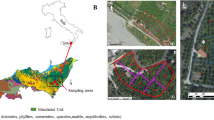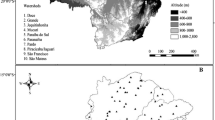Abstract
The background concentration of potentially toxic elements (PTE) in soils is influenced by the parent material composition and soil forming processes. The soil natural concentration of PTE is a first step to establish regulatory levels for the monitoring of these elements in soils suspected of contamination. In the present study, we performed a natural background concentration survey of PTE in soils of the Piauí state, Brazil. The study provides the basis for establishing soil quality reference values (QRVs) for a large area (over 251,000 km2) with different pedological features. A total of 262 geo-referenced soil samples (0.0–0.2 m) were collected in areas relatively undisturbed by human activity. The concentrations of Ba, Cd, Co, Cr, Cu, Fe, Mo, Ni, Pb, Sb, V, and Zn were determined by ICP-OES. Univariate statistical methods and multivariate exploratory techniques were used to understand the relationship between soil characteristics, geological features, and PTE concentrations in soils. The mean background concentrations of PTE in the soils were generally lower than those reported in other countries and/or other Brazilian states, and followed the order: Fe > Ba > V > Cr > Cu > Pb > Zn > Ni > Pb > Co > Mo > Sb > Cd. The main factors governing the concentrations of PTE in soils were the parent material and the soil texture. The different geological features in the study area influenced the spatial distribution of PTE and divided the state into three regions presenting low, high, and intermediate values. Given this geological and pedological complexity, we proposed establishing three sets of QRV rather than a single QRV for the whole state to avoid misinterpretation regarding the investigation of areas suspected of contamination. This background concentration survey contains a wealth of information that provides the basis for the soil guideline values in the state and supports future research on the impact of anthropogenic activities in soil contamination.


Similar content being viewed by others
References
Abbaslou, H., Abtahi, A., & Baghernejad, M. (2013). Effect of weathering and mineralogy on the distribution of major and trace elements (Hormozgan province, Southern Iran). International Journal of Forest, Soil and Erosion, 3, 15–25.
Abdelwaheb, M., Jebali, K., Dhaouadi, H., & Dridi-Dhaouadi., S. (2019). Adsorption of nitrate, phosphate, nickel and lead on soils: Risk of groundwater contamination. Ecotoxicology and Environmental Safety, 179, 182–187.
Agência Estadual de Meio Ambiente – CPRH. (2014). Instrução Normativa N° 007/2014: Estabelece os valores de referência da qualidade do solo (VRQ) do Estado de Pernambuco quanto à presença de substâncias químicas para o gerenciamento ambiental de áreas contaminadas por essas substâncias. CPRH https://www.legisweb.com.br/legislacao/?id=279789. Accessed 13 November 2019.
Alfaro, M. R., Montero, A., Ugarte, O. M., Nascimento, C. W. A., Accioly, A. M. A., Biondi, C. M., et al. (2015). Background concentrations and reference values for heavy metals in soils of Cuba. Environmental Monitoring and Assessment, 187, 4198–4208.
Alloway, B. J. (1990). Heavy metals in soils. Glasgow: Blackie Academic and Professional.
Almeida Júnior, A. B., Nascimento, C. W. A., Biondi, C. M., Souza, A. P., & Barros, F. M. R. (2016). Background and reference values of metals in soil from Paraíba State, Brazil. Revista Brasileira de Ciência do Solo, 40, 1–13.
Althaus, D., Gianello, C., Tedesco, M. J., Silva, K. J., Bissani, C. A., & Felisberto, R. (2018). Natural fertility and metals contents in soils of Rio Grande do Sul (Brazil). Revista Brasileira de Ciência do Solo, 42, e0160418.
Araújo, P. R. M., Biondi, C. M., Silva, F. B. V., Nascimento, C. W. A., & Souza Júnior, V. S. (2018). Geochemical soil anomalies: assessment of risk to human health and implications for environmental monitoring. Journal of Geochemical Exploration, 190, 325–335.
Baize, D., & Sterckeman, T. (2001). Of the necessity of knowledge of the natural pedo-geochemical background content in the evaluation of the contamination of soils by trace elements. Science of the Total Environment, 264, 127–139.
Barbosa Júnior, P., Espindola, G. M., & Carneiro, E. L. N. C. (2016). Cartografias do Piauí: relacionando infraestrutura e desenvolvimento social. Revista Geografia Acadêmica, 10, 56–68.
Bini, C., Sartori, G., Wahsha, M., & Fontana, S. (2011). Background levels of trace elements and soil geochemistry at regional level in NE Italy. Journal of Geochemical Exploration, 109, 125–133.
Biondi, C. M., Nascimento, C. W. A., Neta, A. B. F., & Ribeiro, M. R. (2011). Teores de Fe, Mn, Zn, Cu, Ni e Co em solos de referência de Pernambuco. Revista Brasileira de Ciência do Solo, 35, 1057–1066.
Chen, J., Wei, F., Zheng, C., Wu, Y., & Adrian, D. C. (1991). Background concentrations of elements in soils of China. Water, Air, & Soil Pollution, 57–58, 699–712.
Conselho Nacional do Meio Ambiente – CONAMA. (2009). Resolução N° 420, de 28 de dezembro de 2009. CONAMA http://www2.mma.gov.br/port/conama/legiabre.cfm?codlegi=620. Accessed 10 November 2019.
Díez, M., Simón, M., Martín, F., Dorronsoro, C., García, I., & Van Gestel, C. A. M. (2009). Ambient trace element background concentrations in soils and their use in risk assessment. Science of the Total Environment, 407, 4622–4632.
Environmental Agency of the State of São Paulo – CETESB. (2005). Decisão da Diretoria N° 195/2005/E – Valores Orientadores para Solos e Águas Subterrâneas. http://www.cetesb.sp.gov.br/solo. Accessed 6 October 2019.
Environmental Agency of the State of São Paulo – CETESB. (2014). Report establishment of guiding values for soil and groundwater in the state of São Paulo. São Paulo: CETESB http://www.CETESB.sp.gov.br/userfiles/file/solo/valoresorientadores-2014.pdf. Accessed 6 October 2019.
Food and Agriculture Organization of the United Nations – FAO. (2006). Guidelines for soil description. United Nations. https://inspire.ec.europa.eu/document/FaoPrime. Accessed 10 December 2019.
França, L. C. J., Lisboa, G. S., Silva, J. B. L., Rodolfo Júnior, F., Morais Junior, V. T. M., & Cerqueira, C. L. (2016). Suitability for agricultural and forestry mechanization of the Uruçuí-Preto river hydrographic basin, Piauí, Brazil. Nativa, 4, 238–243.
Instituto Brasileiro de Geografia e Estatística - IBGE. (2011). Censo demográfico 2010 retratos do Brasil e do Piauí. IBGE https://censo2010.ibge.gov.br/sinopse/index.php?uf=22&dados=0. Accessed 10 June 2019.
Instituto Brasileiro de Geografia e Estatística - IBGE. (2015). Manual técnico de pedologia. IBGE. https://biblioteca.ibge.gov.br/. Accessed 01 July 2019.
Köppen, W., & Geiger, R. (1936). Handbuch der klimatologie. Berlin: Gebruder Borntraeger.
Martin, A. P., Turnbull, R. E., Rattenbury, M. S., Cohen, D. R., Hoogewerff, J., Rogers, K. M., Baisden, W. T., & Christie, A. B. (2016). The regional geochemical baseline soil survey of southern New Zealand: design and initial interpretation. Journal of Geochemical Exploration, 167, 70–82.
Nascimento, C. W. A., Lima, L. H. V., Silva, F. L., Biondi, C. M., & Campos, M. C. C. (2018). Natural concentrations and reference values of heavy metals in sedimentary soils in the Brazilian Amazon. Environmental Monitoring and Assessment, 190, 606–614.
Nogueira, T. A. R., Abreu-Junior, C. H., Alleoni, L. R. F., He, Z., Soares, M. R., Vieira, C. S., et al. (2018). Background concentrations and quality reference values for some potentially toxic elements in soils of São Paulo State, Brazil. Journal of Environmental Management, 221, 10–19.
Paye, H. D. S., Mello, J. W. V., Abrahão, W. A. P., Fernades Filho, E. I., Dias, L. C. P., Castro, M. L. O., et al. (2010). Valores de Referência para metais pesados em solos no Estado Espírito Santo. Revista Brasileira de Ciência do Solo, 34, 2041–2051.
Pfaltzgraff, P. A. S., Torres, F. S. M., & Brandão, R. L. (2010). Geodiversidade do Estado do Piauí. CPRM http://rigeo.cprm.gov.br/jspui/handle/doc/16772. Accessed 25 June 2019.
Preston, W., Nascimento, C. W. A., Biondi, C. M., Souza Junior, V. S., Silva, W. R., & Ferreira, H. A. (2014). Valores de referência de qualidade para metais pesados em solos do Rio Grande do Norte. Revista Brasileira de Ciência do Solo, 38, 1028–1037.
Raij, B., Andrande, J. C., Cantarella, H., & Quaggio, J. A. (2001). Análise química para avaliação da fertilidade de solos tropicais. Campinas: IAC.
Salonen, V., & Korkka-Niemi, K. (2007). Influence of parent sediments on the concentration of heavy metals in urban and suburban soils in Turku, Finland. Applied Geochemistry, 22, 906–918.
Santos, S. N., & Alleoni, L. R. F. (2013). Reference values for heavy metals in soils of the Brazilian agricultural frontier in Southwestern Amazônia. Environmental Monitoring and Assessment, 185, 5737–5748.
Serviço Geológico do Brasil - CPMR. (2009). Mapa Geodiversidade do Estado do Piauí. CPMR http://rigeo.cprm.gov.br/jspui/handle/doc/14708. Accessed 10 June 2019.
Silva, Y. J. A. B. da, Nascimento, C. W. A., & do., Biondi, C. M. (2014). Comparison of USEPA digestion methods to heavy metals in soil samples. Environmental Monitoring and Assessment, 186(1), 47–53.
Sneath, P. H. A., & Sokal, R. R. (1973). Numerical taxonomy. San Francisco: Freeman and Co..
Soil Survey Staff. (2014). Keys to soil taxonomy (12th ed.). Washington, DC: USDA - Natural Resources Conservation Service https://www.nrcs.usda.gov/wps/portal/nrcs/detail/soils/survey/class/?cid=nrcs142p2_053580. Accessed 09 June 2019
Souza, J. J. L. L., Abrahão, W. A. P., Mello, J. W. V., Silva, J., Costa, L. M., & Oliveira, T. S. (2015). Geochemistry and spatial variability of metal(loid) concentrations in soils of the state of Minas Gerais, Brazil. Science of the Total Environment, 505, 338–349.
Souza, D. F., Barbosa, R. S., Silva, Y. J. A. B., Moura, M. C. S., Oliveira, R. P., & Martins, V. (2019). Genesis of sandstone-derived soils in the Cerrado of the Piauí State, Brazil. Ambiente & Água, 14, e2355.
Tume, P., Bech, J., Longan, L., Tume, L., Reverter, F., & Sepulveda, B. (2006). Trace elements in natural surface soils in Sant Climent (Catalonia, Spain). Ecological Engineering, 27(2), 145–152.
Tume, P., Bech, J., Reverter, F., Longan, L., Tume, L., & Sepúlveda, B. (2011). Concentration and distribution of twelve metals in Central Catalonia surface soils. Journal of Geochemical Exploration, 109, 92–103.
United States Environmental Protection Agency – USEPA. (2007). Method 3051A – microwave assisted acid digestion of sediments, sludges, soils, and oils. USEPA http://www.epa.gov/osw/hazard/testmethods/sw846/pdfs/3051a.pdf. Accessed 15 June 2019.
Acknowledgments
The authors would like to thank the Coordination for the Improvement of Higher Education Personnel (CAPES) for a master’s degree scholarship for the authors Duarte, LSL; Sena, AFS; and Brito, ACC.
Funding
This work was supported by the Brazilian National Research and Development Council - CNPq (Process Number: 409398/2016-0) and PQ Fellowship/CNPq (Process Number: 303952/2017-2).
Author information
Authors and Affiliations
Corresponding author
Additional information
Publisher’s note
Springer Nature remains neutral with regard to jurisdictional claims in published maps and institutional affiliations.
Rights and permissions
About this article
Cite this article
Boechat, C.L., Duarte, L.d.S.L., de Sena, A.F.S. et al. Background concentrations and quality reference values for potentially toxic elements in soils of Piauí state, Brazil. Environ Monit Assess 192, 723 (2020). https://doi.org/10.1007/s10661-020-08656-w
Received:
Accepted:
Published:
DOI: https://doi.org/10.1007/s10661-020-08656-w




